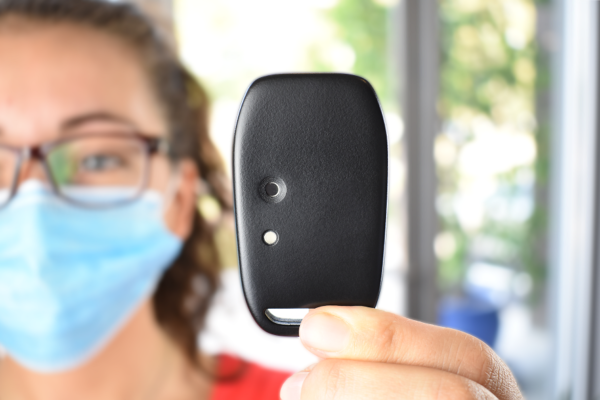
Wireless charging for Covid-19 temperature sensor
The combination of chief operating officer and chief technology officer is rare, but in these Covid-19 pandemic times, having both roles together provides a significant advantage.
“As the COO I was looking at how we bring people back, looking at thermal camera systems, but these need employees to write down the temperature that the system detected,” said Charles Greene, COO and CTO of Powercast. “We have a whole line of RFID tags with PTC tags for building automation and I looked at that and thought we could change the form factor and change it to an IR sensor and use the software from the previous platform.
So Powercast adapted its existing RF energy harvesting transmitter and receiver technology to create a battery-free temperature measuring tag that allows employees to come back to the office safely.
“There’s an RFID antenna on the desk, you hold the fob over the reader and blinks when ready, scan your temperature until a blue LED blinks, then you hold the fob over the reader again to record the value,” he said.
“Out of the gate we wanted to go with a completely battery free system – even with rechargeable batteries they have a finite lifetime – we are using ceramic capacitors so the fob should match the time of the employees with the company,” he said. The fob stays with the employee, avoiding cross-contamination.
“There’s tremendous opportunities to extend the design. It’s been working great for us as its completely no touch,” he said.
This also solved the problems of uniquely identifying the employee and meet the regulations on monitoring temperature. Now as people are walking around the building using readers around the building, if someone does get sick and the company needs to do contact tracing, the data is available.
The RFID tag in the fob has a 3.5m range, and there is a sensor on the doorway to monitor the occupancy of the room. “The RFID comes up quickly, – the thing that takes time is the IR sensor as it needs more power, a second or so,” he said. This allows the location of staff to be monitored for tracing.
“Right now all the data goes into a database on our network but it can be tied into other access control systems through an API. This is more of a small business solution, we are 20 people,
Powercast worked with Microchip to use its microcontroller in the fob. “The key driver on the size of the fob is the size of the antenna,” said Green, and he is talking to Microchip about using the system.
“Microchip has a huge campus in Chandler, you are going to have other access control systems in place and take advantage of their dashboards rather than having a separate system. We are actively discussing using it with Microchip and the goal is to spin the systems into higher volumes. This is a capability that’s out there, based on an existing platform that’s been in the market for five years so it’s a known viable platform and we want to work with other companies to take this into larger facilities,” he added.
Rather than a key fob, the technology could easily be implemented in a wristband or an ID card, he says. “We have implemented Bluetooth Low Energy (BLE) in credit card form factor for smart credit cards so its not impossible. But we have done thicker cards with smart driver licenses, closer to 1mm thick. What drives the thickness is the battery, and we have no battery. We could talk to the manufacturer with a thinner IR sensor if a larger company wanted it. We could put NFC in there alongside for the access control.”
But Powercast is not looking to be a high volume manufacturer.
“We are a product company and the chip is one of the products,” said Greene. “We have provided end transmitter solutions to provide power since 2010 so our business model has been to provide products to the market, from modules to higher level solutions.”
“We have demonstrated a smart cricket ball, but I don’t see Powercast making a smart cricket ball,” he said. “We also do a games console controller, but at the end of the day we are looking to partner with companies in a vertical market rather than make a product in every vertical. If a large company came along and wanted to make the controller for example, we would probably stop making it. We want to partner with companies to help them make the end product, most don’t have the expertise in antenna design for example.”
Related articles
- POWERCAST JOINS RFID GROUP FOR LONG DISTANCE WIRELESS POWER
- FREE SPACE WIRELESS CHARGING FOR ELECTRONIC PAPER DISPLAY TAGS
- WIRELESS POWER FOR GAMING CONTROLLER AND DIGITAL LUGGAGE TAGS
Other articles on eeNews Power
- Tesla moves to cobalt-free silicon battery cell with a new form factor
- Supercapacitors operate at higher voltages
- e-peas signs global supply chain deal with Mouser
 If you enjoyed this article, you will like the following ones: don't miss them by subscribing to :
eeNews on Google News
If you enjoyed this article, you will like the following ones: don't miss them by subscribing to :
eeNews on Google News




